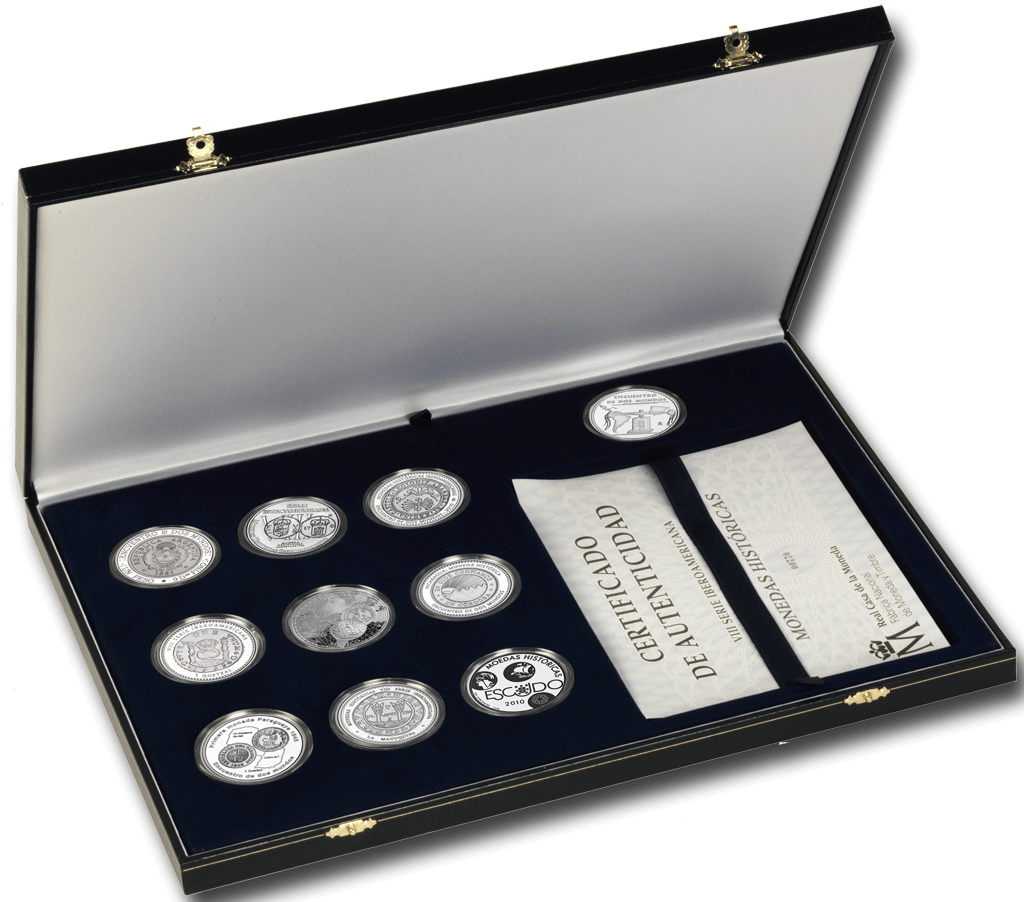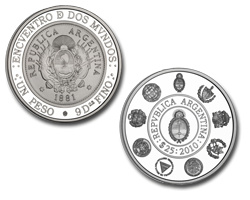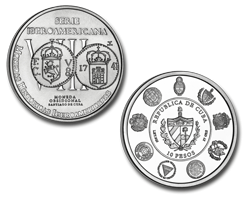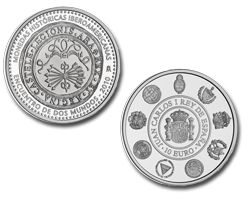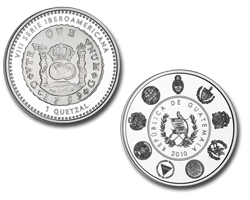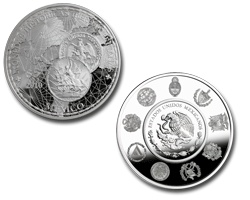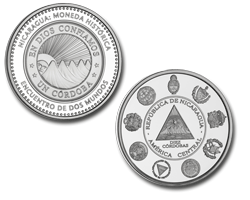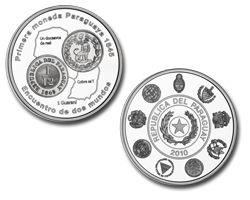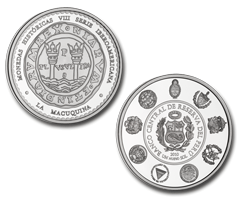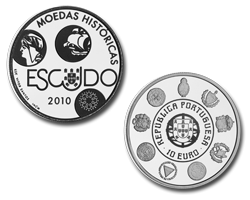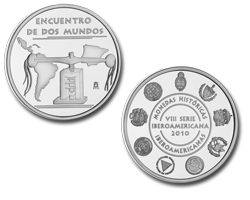8th Ibero-American Series : Historic Ibero-American Coins
Introduction
This 8th Ibero-American Series is dedicated to the Historic Ibero-American Coins on account of the great significance that the minting of coins has always had in the Ibero-American sphere of influence. The great variety displayed by the countries in selecting their historic coins attests to the numismatic treasure held in the possession of our Ibero-American world.
The set is composed of nine coins, one for each participating country, and a sterling silver medal commemorating the 8th Ibero-American Series. As in the previous series, the nine coins are minted in proof quality. The maximum mint run for this set is 12,000 units.
Other issues in this series: (5th Series) (6th Series) (7th Series)
Details
A unique feature of this series is that each participating country has accepted that its national coat-of-arms appear on the coins of the other nations involved, something that has never occurred before in twenty-five centuries of Numismatic History.
The reverse sides of the coins, therefore, show the national coat-of-arms of the issuing country surrounded by the coats-of-arms of the other participating nations.
| Name | Face value | Weight | Diameter |
|---|---|---|---|
| 8-reales silver Argentina | 25 Pesos | 27,00 g | 40,00 mm |
| 8-reales silver Cuba | 10 Pesos | 27,00 g | 40,00 mm |
| 8-reales silver Spain | 10 Euros | 27,00 g | 40,00 mm |
| 8-reales silver Guatemala | 1 Quetzal | 27,00 g | 40,00 mm |
| 8-reales silver Mexico | 5 Pesos | 27,00 g | 40,00 mm |
| 8-reales silver Nicaragua | 10 Córdobas | 27,00 g | 40,00 mm |
| 8-reales silver Paraguay | 1 Guaraní | 27,00 g | 40,00 mm |
| 8-reales silver Peru | 1 Nuevo Sol | 27,00 g | 40,00 mm |
| 8-reales silver Portugal | 10 Euros | 27,00 g | 40,00 mm |
| 8-reales silver Medal | ----- | 27,00 g | 40,00 mm |
8-reales silver Argentina
The obverse reproduces a replica of the obverse of the country's first 1-Peso coin minted in silver after 1881. This coin was popularly known as the patacon, the colloquial term used to designate colonial Spanish-American coins of similar characteristics.
The center of the reverse side features the arms of Argentina. Shown surrounding this central motif, and in alphabetical order clockwise, are the national coats-of-arms of the other countries that are participating in this issue.
8-reales silver Cuba
The obverse reproduces a coin minted during the siege by the British of the city of Santiago de Cuba from July 29 to December 19, 1741. The coin issue was decided upon by the City Council and the city's Governor.
The center of the reverse side features the arms of Cuba. Shown surrounding this central motif, and in alphabetical order clockwise, are the national coats-of-arms of the other countries that are participating in this issue.
8-reales silver Spain
The obverse reproduces the reverse of an 8-reales coin that was struck in Seville under the Catholic Monarchs Isabella I and Ferdinand V of Castile. The mint mark, assayer's mark and face value were stamped on the obverse. So the symbols of the yoke and the arrows also appear on all the coins from 1 to 8 reales that were struck by any of the mints under these monarchs.
The center of the reverse side features the arms of Spain. Shown surrounding this central motif, and in alphabetical order clockwise, are the national coats-of-arms of the other countries that are participating in this issue.
8-reales silver Guatemala
The obverse reproduces the first orbicular or circular coin that was minted in Guatemala after 1754. It is a silver coin of the "pillar" design type. The inclusion of the letter "G" identifies the Guatemalan mint. This design was utilized by different American mints during the same period of time.
The center of the reverse side features the arms of Guatemala. Shown surrounding this central motif, and in alphabetical order clockwise, are the national coats-of-arms of the other countries that are participating in this .
8-reales silver Mexico
The obverse reproduces the obverse and the reverse of the 1-Peso coins commonly called pesos del caballito and struck in 1910 during the decline of the Porfirio Diaz dictatorship. The obverse displays the country's coat-of-arms charged with a spirited Mexican eagle, facing front with wings outspread. The reverse depicts an equestrian figure of Liberty.
The center of the reverse side features the arms of Mexico. Shown surrounding this central motif, and in alphabetical order clockwise, are the national coats-of-arms of the other countries that are participating in this issue.
8-reales silver Nicaragua
The obverse reproduces the reverse of the first coins minted in the cordoba currency, created in March 1912 to replace the Peso. It shows the face of a rising sun radiating over a range of five volcanoes that represent the five Central American countries. This design has its origin in the metal 1-real coin which was struck in 1824 by the Central American Federation three years after the Central American countries had gained independence from Spain.
The center of the reverse side features the arms of Nicaragua. Shown surrounding this central motif, and in alphabetical order clockwise, are the national coats-of-arms of the other countries that are participating in this issue.
8-reales silver Paraguay
The obverse reproduces a coin known by the name of cobrecito de leon, an allusion to its slight worth. These coins were minted in the city of Birmingham (England). They were released into circulation by a decree dated March 1847 and they circulated until 1877. Twelve copper coins represented one real; eight reales made up one peso.
The center of the reverse side features the arms of Paraguay. Shown surrounding this central motif, and in alphabetical order clockwise, are the national coats-of-arms of the other countries that are participating in this issue.
8-reales silver Peru
The obverse reproduces the reverse of the first coin struck at the Mint of Lima in 1568. These coins featured the two Pillars of Hercules surmounted by crowns, standing on ocean waves, with the legend "PLUS ULTRA" that had been the imperial motto of Carlos V in reference to the scope of Spain's power overseas. Also shown is a letter "P" indicating Peru as the place of minting.
The center of the reverse side features the arms of Peru. Shown surrounding this central motif, and in alphabetical order clockwise, are the national coats-of-arms of the other countries that are participating in this issue.
8-reales silver Portugal
The obverse is dedicated to the Escudo, the currency that replaced the 1000-reales by the Decree of May 22, 1911, after the establishment of the Republic. The design, in deference to the fact that the escudo still very much abides in the sentiment of the Portuguese public, utilizes the visual space of the coin to trace a trip back through time and through memory.
The center of the reverse side features the arms of Portugal. Shown surrounding this central motif, and in alphabetical order clockwise, are the national coats-of-arms of the other countries that are participating in this issue.
8-reales silver Medal
As in earlier editions of the Ibero-American Series, the nine coins from the different countries taking part are accompanied by a Commemorative Medal.
The obverse features the maps of the Iberian Peninsula and of Central and South America, linked by a fly press. It also shows the mint mark of the Spanish Royal Mint and the legend "A Meeting of Two Worlds".
The reverse presents an inner circle displaying the title of the 8th Series, "Historic Ibero-American Coins", surrounded by a border featuring the coats-of-arms of the participating countries.
Prices
Official retail price in Spain, excluding any relevant taxes:
Coin set
Complete boxed set - 420 Euros

